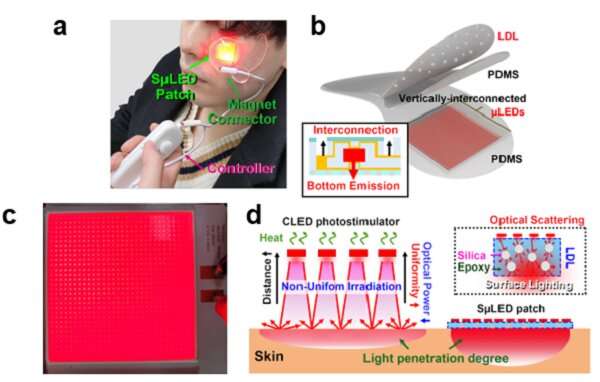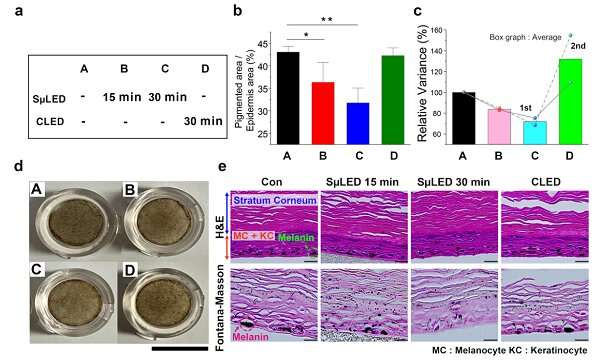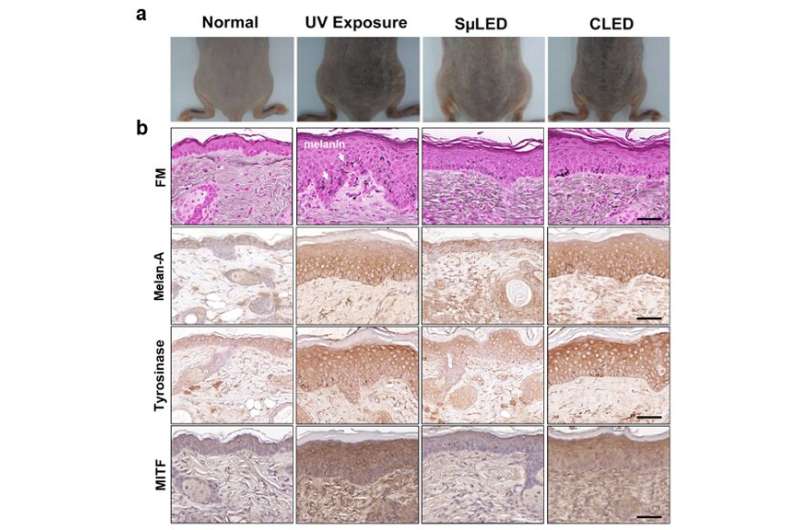Research team develops a surface-lighting microLED patch with significant melanogenesis inhibition effect

A KAIST research team led by Ph.D. candidate Jae Hee Lee and Professor Keon Jae Lee from the Department of Materials Science and Engineering has developed a surface-lighting microLED patch for UV-induced melanogenesis inhibition. The team’s research was published in Advanced Healthcare Materials.
Melanin is brown or dark pigments existing in the skin, which can be abnormally synthesized by external UV or stress. Since the excessive melanin leads to skin diseases such as spots and freckles, proper treatment is required to return normal skin condition.
Recently, LED-based photo-stimulators have been released for skin care; however, their therapeutic effect is still controversial. Since conventional LED stimulators cannot conformally attach to the human skin, distance-induced side effects are caused by light loss and high heat transfer. To achieve effective photo treatment, the LED stimulator must be irradiated in contact with the human skin surface, enabling proper and uniform light delivery to the dermis with minimal optical loss.

Within this work, the research team fabricated a skin-attachable surface-lighting microLED (SµLED, 4 × 4 cm2) patch by utilizing a thousand microLED chips and a silica-embedded light diffusion layer. The group of 100 µm-sized LED chips is vertically interconnected for high flexibility and low heat generation, allowing its long-term operation on the human skin.
The research team confirmed melanogenesis inhibition by irradiating the SµLED patch and the conventional LED (CLED) on the artificial human skin and mice dorsal skin. The SµLED-treated groups of human cells and mouse tissues showed minimal epidermal phototoxicity and consistently effective reduction in synthesized melanin, compared to CLED-treated groups.
In addition, the team verified significant suppression of protein/catalyst expression involved in melanin synthesis, such as MITF (microphthalmia-associated transcription factor), Melan-A and tyrosinase.

Prof. Keon Jae Lee said, “Our inorganic-based SµLED patch has outstanding characteristics in light efficiency, reliability, and durability. The SµLED patch is expected to give a great impact on the cosmetic field by reducing side effects and maximizing phototherapeutic effects.”
The core technology of cosmetic SµLED has been transferred to Fronics co., Ltd, founded by Prof. Lee. Fronics is building foundry and equipment for mass production of SµLED masks for whole face cover and plans to release the products in March next year.
More information:
Jae Hee Lee et al, Wearable Surface‐Lighting Micro‐Light‐Emitting Diode Patch for Melanogenesis Inhibition, Advanced Healthcare Materials (2022). DOI: 10.1002/adhm.202201796
Journal information:
Advanced Healthcare Materials
Source: Read Full Article
